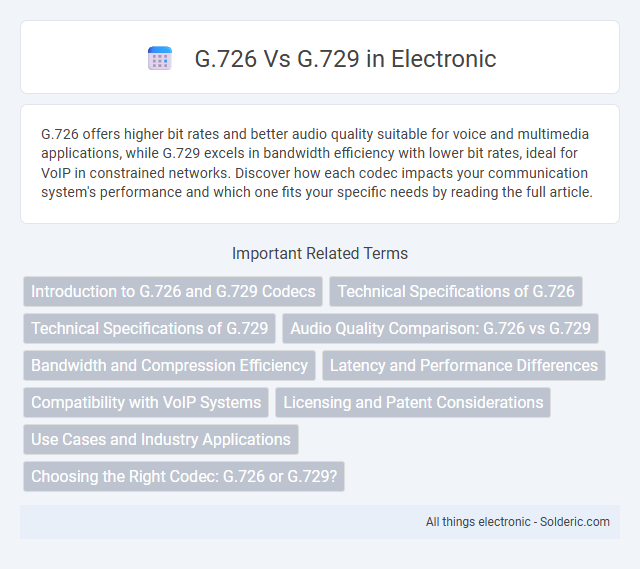G.726 offers higher bit rates and better audio quality suitable for voice and multimedia applications, while G.729 excels in bandwidth efficiency with lower bit rates, ideal for VoIP in constrained networks. Discover how each codec impacts your communication system's performance and which one fits your specific needs by reading the full article.
Comparison Table
| Feature | G.726 | G.729 |
|---|---|---|
| Codec Type | ADPCM (Adaptive Differential Pulse Code Modulation) | CS-ACELP (Conjugate-Structure Algebraic-Code-Excited Linear Prediction) |
| Bitrate | 16, 24, 32, 40 kbps | 8 kbps |
| Latency | Low (around 0.25 ms per sample) | Medium (about 15 ms frame size + 5 ms algorithmic delay) |
| Audio Quality | Good for voice, less compression artifacts | High compression with good voice quality at low bitrate |
| Complexity | Low complexity, easy implementation | Medium complexity, requires more processing power |
| Use Cases | Telephony, VoIP with moderate bandwidth | VoIP, bandwidth-constrained environments |
| Standardization | ITU-T Recommendation G.726 | ITU-T Recommendation G.729 |
Introduction to G.726 and G.729 Codecs
G.726 and G.729 codecs are widely used for compressing voice signals in telecommunications. G.726 supports bit rates of 16, 24, 32, and 40 kbps using Adaptive Differential Pulse Code Modulation (ADPCM), offering a balance between audio quality and bandwidth efficiency. Your choice between these codecs depends on network constraints, with G.729 providing higher compression at 8 kbps using Conjugate-Structure Algebraic Code-Excited Linear Prediction (CS-ACELP), ideal for low-bandwidth environments.
Technical Specifications of G.726
G.726 is an ITU-T standard for ADPCM (Adaptive Differential Pulse Code Modulation) voice compression operating at 16, 24, 32, and 40 kbps bit rates, supporting various audio quality and bandwidth trade-offs. It uses 40 ms frames and encodes 8 kHz sampled audio with 16-bit linear PCM input, optimizing for low latency in telephony applications. The codec offers moderate compression while maintaining acceptable voice quality, making it suitable for legacy telecommunication systems and Voice over IP (VoIP) scenarios where bandwidth efficiency is important.
Technical Specifications of G.729
G.729 is an ITU-T standard for audio data compression using Conjugate-Structure Algebraic-Code-Excited Linear Prediction (CS-ACELP) coding at 8 kbps, designed primarily for voice applications. It operates at an 8 kHz sampling frequency, compressing voice data efficiently while maintaining acceptable voice quality, making it ideal for VoIP and low-bandwidth environments. G.729 supports frame sizes of 10 ms, balancing latency and compression to optimize network performance in real-time communications.
Audio Quality Comparison: G.726 vs G.729
G.726 and G.729 both serve as audio codecs designed for voice compression, with G.726 using ADPCM and offering bit rates of 16, 24, 32, and 40 kbps, while G.729 employs Conjugate-Structure Algebraic-Code-Excited Linear Prediction (CS-ACELP) at a fixed 8 kbps bitrate. In terms of audio quality, G.726 typically provides higher quality voice samples due to its higher bitrate options, making it suitable for LAN and high-bandwidth networks, whereas G.729's lower bitrate prioritizes bandwidth efficiency at the cost of slightly reduced audio fidelity, beneficial in constrained network environments like VoIP over WAN. The choice between G.726 and G.729 hinges on the balance desired between available bandwidth and acceptable voice quality for specific telecommunication applications.
Bandwidth and Compression Efficiency
G.726 offers variable bit rates of 16, 24, 32, and 40 kbps, balancing moderate bandwidth use with reasonable audio quality through Adaptive Differential Pulse Code Modulation (ADPCM). G.729 uses a fixed bit rate of 8 kbps, providing superior compression efficiency and bandwidth savings ideal for VoIP applications while maintaining acceptable voice clarity via Conjugate-Structure Algebraic-Code-Excited Linear Prediction (CS-ACELP). Your choice between G.726 and G.729 should consider the trade-off between bandwidth availability and the desired audio quality, where G.729 excels in low-bandwidth environments.
Latency and Performance Differences
G.726 codec offers lower latency compared to G.729, making it suitable for real-time communication where delay sensitivity is critical. While G.729 provides better compression efficiency with lower bitrate usage, its computational complexity induces higher processing delay and impacts performance in bandwidth-constrained environments. Your choice between G.726 and G.729 should consider the trade-off between latency requirements and network bandwidth availability for optimized voice quality.
Compatibility with VoIP Systems
G.726 offers broad compatibility with many VoIP systems due to its adaptive bit rates ranging from 16 to 40 kbps, supporting a variety of network conditions and legacy equipment. G.729 provides high compression efficiency at 8 kbps, making it suitable for bandwidth-constrained VoIP environments but requiring licensing, which may limit integration in some open-source or cost-sensitive systems. Your choice between G.726 and G.729 should consider the specific VoIP system requirements, codec support, and network bandwidth availability.
Licensing and Patent Considerations
G.726 operates under royalty-free licensing, making it a cost-effective choice for developers and manufacturers seeking to avoid patent fees. In contrast, G.729 requires licensing fees due to patented compression technology, which may increase the total cost of deployment. Organizations must evaluate the impact of these licensing differences on their project's budget and long-term scalability.
Use Cases and Industry Applications
G.726 is commonly used in legacy telephony systems and voice over IP (VoIP) applications requiring moderate bandwidth, such as call centers and IP PBX systems, due to its balance of compression and speech quality at bit rates of 16, 24, 32, or 40 kbps. G.729 is favored in bandwidth-constrained environments like mobile networks, conferencing systems, and VoIP endpoints where low bitrate (8 kbps) compression provides efficient voice quality and reduced network load. Your choice between G.726 and G.729 depends on the specific industry needs for bandwidth efficiency versus compatibility and voice clarity.
Choosing the Right Codec: G.726 or G.729?
G.726 offers higher bitrate options ranging from 16 to 40 kbps, delivering better audio quality ideal for applications requiring clear voice transmission. G.729 compresses audio at 8 kbps, optimizing bandwidth usage while maintaining acceptable voice clarity, making it suitable for networks with limited capacity. Choosing the right codec depends on your balance between bandwidth efficiency and audio fidelity needs in VoIP implementations.
G.726 vs G.729 Infographic

 solderic.com
solderic.com